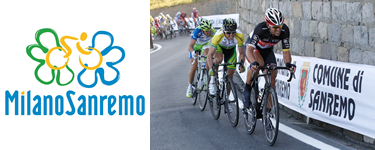Coppi's Epic Journey
Milan-San Remo is the first big (Traditional Classic) race of the year. It generally attracts a huge amount of interest from the media, who during the winter months starve for news worthy stories. This legendary ‘Cycling Tale' begins in March of 1946 with “Coppi's Epic Journey”.
M-SR is a link to the legendary, bygone days when races were long and tedious compared to the standard, shorter but harder paced classics of today. The race is long at 294km (about 185 miles) and requires great early season training to compete for this prestigious victory. The race's traditional route leaves the City of Milan from the main square outside the Cathedral, heads out across the plains of Lombardy towards the climb of the Turchino Pass (the biggest climb in the race), then drops down to the Liguran coast at Genoa and follows the coast all the way to the finish on the Via Roma in San Remo.
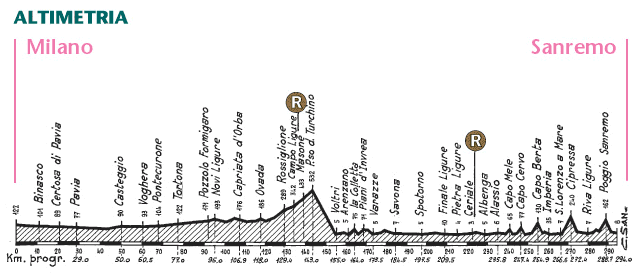
*Race profile courtesy of Internet site: www.econ-outlook.com.au/tom/cycling/palmares.html
Milan-San Remo was first run in 1907 and except for 1916 ran consecutively until 1944 & 1945 when WW2 canceled the event. Italy was staggering after World War 2, cities were destroyed, jobs were scarce, the roads were not paved, and TV coverage did not exist. The radio broadcast gave the only link to the racing action and the beleaguered people of Italy were glued to the audio action of the race.

The great Fausto Coppi (CR Archive)
March 19, 1946, the race called La Primavera, would provide the stage for the re-emergence of a great champion. Campionissimo (Italian champion of champions) Fausto Coppi had prepared very seriously for this race with over 7,000 km (4,400 miles) of training from January 1 to race day. The sprinters attacked from the start of the race trying to gain an advantage for the many early monetary prizes (‘primes') offered by the small towns across the plains of Lombardy. Coppi found himself drawn into a count-attack after only 50 km of racing. The Italian radio commentator proclaimed Coppi's move as "Sheer Madness". All of Italy knew that their hero Gino Bartali would catch and pass him on the Turchino Pass. Coppi seemed to disagree, he caught the small group of sprinters before the base of Turchino and proceeded to systematically shed his breakaway companions one by one. Finally only original attacker Frenchman Lucien Teisseire could stay with the flying Italian. The Frenchman's glory would be short-lived; halfway to the summit of Turchino, Coppi's smooth pedaling opened a gap that would not be closed. A solo Coppi entered a short, dark tunnel at the summit of the Turchino Pass. Claude Tillet, L'Equipe's main reporter for the race, eloquently set forth one cycling's great legends:
The tunnel was of modest dimensions, just 50 meters long, but on 19 March 1946 it assumed exceptional proportions in the eyes of the World. That day it was six years in length and lost the in the gloom of the war... A rumbling was heard from the depths of those six years and suddenly there appeared in the light of day an olive-greenish car stirring up a cloud of dust. “Arriva Coppi” the messenger announced, a revelation only the initiated had foreseen.
There were still 145 km (approx. 90 miles) from the top of Turchino to the finish on the "Via Roma" in San Remo. Coppi never looked back. When told the peloton was 2 minutes behind at the bottom of the climb he upped his tempo and extended his lead. He rode solo over the final distance for the victory some 14 minutes ahead of the gallant Lucien Teisseire who himself had managed to stay well ahead of the beaten peloton.
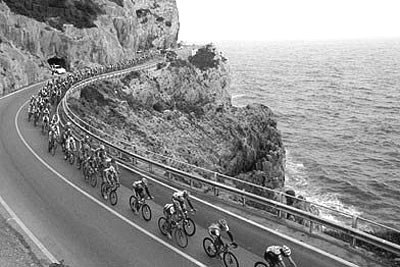
Peloton cruising along the Mediterranean coast
Coppi's epic journey provided a great distraction for the war torn country of Italy. From Coppi being in a British 'prisoner of war camp' to top of the cycling world, Fausto Coppi's status as a legend had added a new chapter!!!
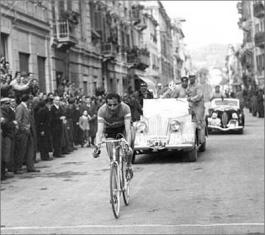
SPECIAL NOTE: The 1946 M-SR also marked the start of a great cycling rivalry. It was the political dictates of war that kept Coppi and Bartali apart and it was the M-SR that brought them back together. This race left no doubt that Fausto Coppi was the best in 1946, but the rivalry had been rekindled. It would be a rivalry that made both men excel over the next decade and a rivalry that helped Italy heal the wounds of war.
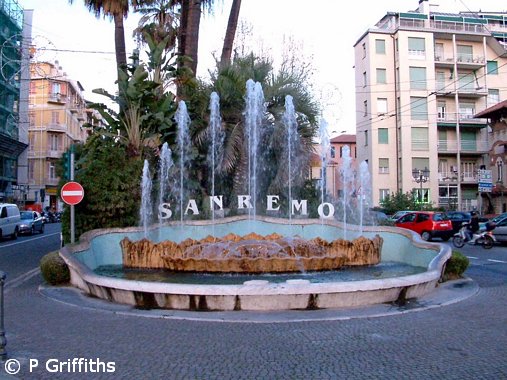
Entry to the finish straight ( Image © M-SR: P Griffiths Easy Imager )
M-SR March 19, 1946 |
293 Km |
1.
Fausto COPPI (Ita) 8h09'00" |
2.
Lucien Teisseire (Fra) +14'00"
|
3.
Mario Ricci (Ita) +18'30"
|
Starters: 115 |
| Finishers: 63 |
Average Speed: 35.952 km/h |
M-SR 1943
M-SR 1947
Return to the Timeline ToC
Return to the Race Snippets ToC |
